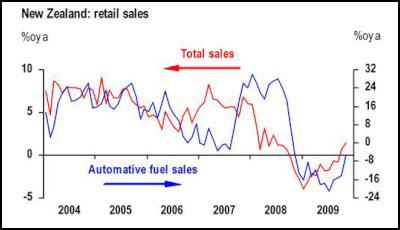Consumer spending surged in November
Consumer spending surged in New Zealand in November
Click here for the full Note and disclosures.
Consumer spending in New Zealand is strengthening, with retail sales numbers this morning providing further evidence that the domestic economy is garnering momentum. Statistics New Zealand reported that total retail sales spiked 0.8%m/m in November (J.P. Morgan and consensus: 0.5%m/m) or 1.5% from a year earlier, marking the largest on-year-ago rise since mid-2008. Core retail sales also surged 0.8% over the month, with low interest rates, strong net migration flows, and the positive wealth effects from recent house price gains creating a favourable retail environment. Discretionary spending was firm, with solid gains reported in ‘other’ retailing (+7.3%) and department store sales (+3.5%). Other significant increases were reported in automotive fuel retailing (+3.8%), liquor retailing (+9.0%), automotive electrical, smash repairs, and tyres (+8.0%), and clothing and soft-goods retailing (+2.9%).
The monthly economic indicators emerging from New Zealand indicate that the economy is firmly on the recovery path, confirming that current policy settings (the cash rate remains at a record low 2.5%) are too accommodative. Though some argue the fourth quarter CPI data released yesterday, which printed on the lower side of expectations, bought the RBNZ more time to sit on the policy sidelines, we maintain our call that the RBNZ will deliver its first rate hike in March, ahead of official guidance. The medium term inflation outlook is a significant concern - domestic prices are rising and excess capacity is diminishing – as is the recent pickup in housing activity. Indeed, the RBNZ will be reluctant to leave the cash rate too low for too long, risking runaway credit growth and another debt-fueled house price bubble. The next key event to watch is, of course, the OCR announcement next week. We will closely scrutinize the statement accompanying what is likely to be a ‘no change’ decision for further clues on the timing of the first rate move.

Click to enlarge

Click to enlarge
ENDS


 The Conversation: As More Communities Have To Consider Relocation, We Explore What Happens To The Land After People Leave
The Conversation: As More Communities Have To Consider Relocation, We Explore What Happens To The Land After People Leave Bill Bennett: Satellite TXT expands, how Egmont Village got a fibre network
Bill Bennett: Satellite TXT expands, how Egmont Village got a fibre network Community Access Media Alliance: Proposed Spectrum Fee Increases Threaten New Zealand’s Community Access Media Sector
Community Access Media Alliance: Proposed Spectrum Fee Increases Threaten New Zealand’s Community Access Media Sector Brewers Association: Brewers Association Of New Zealand Supports Modernisation Of Alcohol Legislation
Brewers Association: Brewers Association Of New Zealand Supports Modernisation Of Alcohol Legislation Commerce Commission: ComCom Warns Of Pyramid Schemes After South Auckland Scammers Plead Guilty
Commerce Commission: ComCom Warns Of Pyramid Schemes After South Auckland Scammers Plead Guilty MBIE: MBIE Publish Mid-Point Review Of The Phase-Out Of The Low Fixed Charge (LFC)
MBIE: MBIE Publish Mid-Point Review Of The Phase-Out Of The Low Fixed Charge (LFC)



